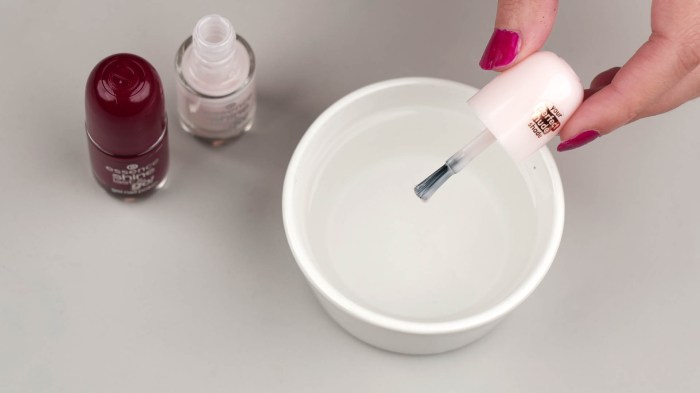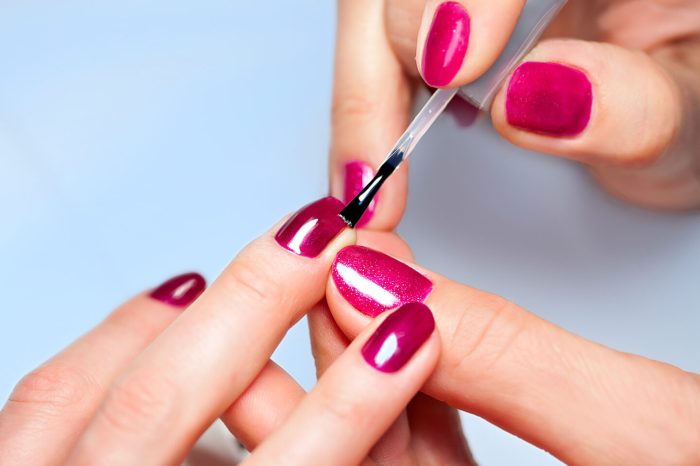Can You Mix Nail Polish Colors?
Mixing Nail Polish Colors: A Comprehensive Guide: Can You Mix Nail Polish Colors
Can you mix nail polish colors – Mixing nail polish colors opens a world of creative possibilities, allowing you to achieve unique shades and designs not found in stores. This guide provides techniques, color theory insights, and troubleshooting tips to help you master the art of nail polish mixing.
Mixing Nail Polish Techniques

Source: wikihow.com
Several methods facilitate effective nail polish mixing. Swirling, layering, and using a palette each offer unique advantages and results.
- Swirling: This involves directly combining polishes on the nail. It’s quick but less precise for achieving consistent color.
- Layering: Applying thin coats of different polishes sequentially, allowing each layer to dry slightly before applying the next, creates depth and subtle color shifts.
- Palette Mixing: Using a palette (like a plastic sheet or foil) allows for precise mixing and color control before application.
Here’s a step-by-step guide to layering:
- Apply a base coat.
- Apply a thin coat of the first color, allowing it to dry slightly.
- Apply a thin coat of the second color, again allowing it to dry.
- Repeat layering until desired color is achieved. Finish with a top coat.
For smooth blends, use thin coats and let each layer dry partially before applying the next. Gentle blending with a toothpick or small brush can help achieve even distribution.
| Method | Description | Pros | Cons |
|---|---|---|---|
| Swirling | Directly combining polishes on the nail. | Fast, convenient. | Less precise color control, potential for unevenness. |
| Layering | Applying thin coats sequentially, allowing each to dry slightly. | Precise color control, creates depth and subtle shifts. | More time-consuming. |
| Palette Mixing | Mixing polishes on a separate palette before application. | Most precise control, consistent color. | Requires extra materials and steps. |
Color Theory and Nail Polish Mixing
Understanding color theory significantly impacts the outcome of nail polish mixing. Complementary, analogous, and triadic color schemes create different visual effects.
Predicting the resulting color involves considering the undertones and saturation of the polishes being mixed. For example, mixing a warm red with a cool blue might produce a muted brownish-purple, while mixing two similar shades of pink will create a deeper, more saturated pink.
Imagine mixing a bright yellow (warm) with a cool blue: the result would be a greenish hue, less vibrant than the original yellow. Conversely, mixing a warm orange with a warm red creates a richer, deeper orange. The visual difference between mixing warm and cool tones lies in the resulting intensity and undertones; warm mixes often appear richer and more saturated, while cool mixes can be more muted or grayish.
Types of Nail Polish and Mixability, Can you mix nail polish colors

Source: makeupmuddle.com
Different nail polish types (cream, shimmer, glitter) exhibit varying degrees of mixability. Cream polishes generally blend well, while shimmer and glitter polishes can present challenges.
- Successful Combinations: Cream polishes mixed with other cream polishes; cream polishes with a small amount of shimmer for added sparkle.
- Unsuccessful Combinations: Mixing large amounts of glitter with cream polishes can result in a clumpy, uneven finish. Mixing drastically different textures can lead to unpredictable results.
Here’s a list of nail polish types and their recommended mixing partners:
- Cream: Mixes well with other creams and some shimmers.
- Shimmer: Best mixed sparingly with cream polishes for added sparkle.
- Glitter: Use sparingly; mixing with other glitter types can create interesting effects but often requires careful application.
Troubleshooting Common Mixing Problems

Source: walmartimages.com
Several issues can arise during nail polish mixing. Understanding these problems and their solutions ensures a smooth process.
Clumping: This often occurs when mixing polishes with different formulas or when using too much of one polish. Solution: Use small amounts of each polish, mix gently, and thin with a nail polish thinner if necessary.
Streaking: This is usually caused by uneven mixing or applying thick coats. Solution: Mix thoroughly, use thin coats, and allow each layer to dry slightly before applying the next.
Uneven Color: This can result from inadequate mixing or inconsistent application. Solution: Mix thoroughly on a palette before applying and use even strokes during application.
Creative Nail Art Ideas Using Mixed Colors
Custom-mixed nail polishes unlock endless creative nail art possibilities.
- Ombre effect: Gradually blending two or more colors on each nail.
- Color blocking: Using distinct blocks of custom-mixed colors on each nail.
- Water marble effect: Creating swirling patterns using mixed polishes in water.
For example, a custom-mixed teal shade (blue and green) can be used to create a beautiful water marble design, adding white or silver accents for contrast.
Experiment with combining warm and cool tones to achieve various aesthetic effects. For example, a mix of warm oranges and reds can create a fiery sunset look, while a combination of cool blues and purples evokes a calming, serene feel.
Q&A
Can I mix nail polish from different brands?
Generally, yes, but results may vary. Some brands may have different formulas that don’t blend as seamlessly.
How do I thin out thick mixed nail polish?
Add a few drops of nail polish thinner or acetone (use sparingly!). Shake gently to combine.
How long does mixed nail polish last?
Mixed nail polish may not last as long as unopened polish. Store it properly in a cool, dark place to extend its lifespan.
What happens if I mix too many colors?
The result might be a muddy or unpredictable color. Start with two colors and gradually add more until you achieve your desired shade.
















